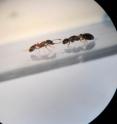Vicious queen ants use mob tactics to reach the top
Leptothorax acervorum ants live all over the Northern hemisphere, but their reproductive strategy depends on habitat. Colonies are polygynous (more than one queen) in the forest of Siberia and central Europe, but functionally monogynous (only one queen reproduces) on sun-exposed slopes in Alaska, Hokkaido and the mountains of central Spain. New research published in BioMed Central's open access journal BMC Ecology demonstrates that when a colony is functionally monogynous not only do queen ants fight by antennal boxing to become the reproductive queen, but that worker ants reinforce queen behaviour by feeding dominant females and expelling, or killing, their weaker sisters. Researchers from University of Regensburg studied the behaviour of L. acervorum in Spain. In these colonies only a single queen was able to reproduce. All the other queens either did not yet have active ovaries, or their ovaries had reverted to an inactive state. The ants were observed fighting, both queen to queen, and worker ants to queens. However the inter-queen fighting involved ritualistic antennal boxing and mandible threats, while the workers were more vicious, and also pulled and bit low ranking queens.
The top queen was decided by the infighting between the queens. However queen reproductive status was not predicted by worker ants' violence but rather was reinforced by the workers feeding and grooming the more dominant queens.
Juergen Trettin, the lead scientists involved in the research said: "These ants live high on mountain slopes -- which makes dispersal and colony formation difficult. Under these circumstances the colony cannot support more than one reproductive queen and limited resources make it inadvantageous for the colony to allow low ranking queens to leave and start their own colonies. Destruction of habitat, for instance due to climate change, may cause this behaviour to become extinct."
Recommend this story on Facebook, Twitter,
and Google +1:
Source: BioMed Central
Other sources
- Vicious queen ants use mob tactics to reach the topfrom Science DailyFri, 30 Sep 2011, 10:30:22 UTC
- Vicious queen ants use mob tactics to reach the topfrom PhysorgFri, 30 Sep 2011, 9:30:18 UTC
